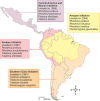Chagas disease: control, elimination and eradication. Is it possible?
- PMID: 24402148
- PMCID: PMC4005548
- DOI: 10.1590/0074-0276130565
Chagas disease: control, elimination and eradication. Is it possible?
Abstract
From an epidemiological point of view, Chagas disease and its reservoirs and vectors can present the following characteristics: (i) enzooty, maintained by wild animals and vectors, with broad occurrence from southern United States of America (USA) to southern Argentina and Chile (42ºN 49ºS), (ii) anthropozoonosis, when man invades the wild ecotope and becomes infected with Trypanosoma cruzi from wild animals or vectors or when the vectors and wild animals, especially marsupials, invade the human domicile and infect man, (iii) zoonosis-amphixenosis and exchanged infection between animals and humans by domestic vectors in endemic areas and (iv) zooanthroponosis, infection that is transmitted from man to animals, by means of domestic vectors, which is the rarest situation in areas endemic for Chagas disease. The characteristics of Chagas disease as an enzooty of wild animals and as an anthropozoonosis are seen most frequently in the Brazilian Amazon and in the Pan-Amazon region as a whole, where there are 33 species of six genera of wild animals: Marsupialia, Chiroptera, Rodentia, Edentata (Xenarthra), Carnivora and Primata and 27 species of triatomines, most of which infected with T. cruzi . These conditions place the resident populations of this area or its visitors - tourists, hunters, fishermen and especially the people whose livelihood involves plant extraction - at risk of being affected by Chagas disease. On the other hand, there has been an exponential increase in the acute cases of Chagas disease in that region through oral transmission of T. cruzi , causing outbreaks of the disease. In four seroepidemiological surveys that were carried out in areas of the microregion of the Negro River, state of Amazonas, in 1991, 1993, 1997 and 2010, we found large numbers of people who were serologically positive for T. cruzi infection. The majority of them and/or their relatives worked in piassava extraction and had come into contact with and were stung by wild triatomines in that area. Finally, a characteristic that is greatly in evidence currently is the migration of people with Chagas disease from endemic areas of Latin America to non-endemic countries. This has created a new dilemma for these countries: the risk of transmission through blood transfusion and the onus of controlling donors and treating migrants with the disease. As an enzooty of wild animals and vectors, and as an anthropozoonosis, Chagas disease cannot be eradicated, but it must be controlled by transmission elimination to man.
Figures



References
-
- Abad-Franch F, Monteiro FA. Biogeography and evolution of Amazonian triatomiones (Hemiptera: Reduviidae): implications for Chagas disease surveillance in humid forest ecoregions. Mem Inst Oswaldo Cruz. 2007;102(I):57–69. - PubMed
-
- Amelotti I, Catalá SS, Gorla DE. The residual efficacy of a cypermethrin pour-on formulation applied on goats on the mortality and blood intake of Triatoma infestans. Mem Inst Oswaldo Cruz. 2012;107:1011–1015. - PubMed
-
- Brum-Soares LM, Xavier SS, Sousa AS, Pereira JB, Ferreira JMBB, Costa IR, Junqueira ACV, Coura JR. Morbidade da doença de Chagas em pacientes autóctones da microrregião do Rio Negro, estado do Amazonas. Rev Soc Bras Med Trop. 2010;43:170–177. - PubMed
-
- Coura JR. Transmisão da infeccção chagásica por via oral na história natural da doença de Chagas. Rev Soc Bras Med Trop. 2006;39(IV):113–117. - PubMed
Publication types
MeSH terms
LinkOut - more resources
Full Text Sources
Other Literature Sources
Medical
Research Materials

